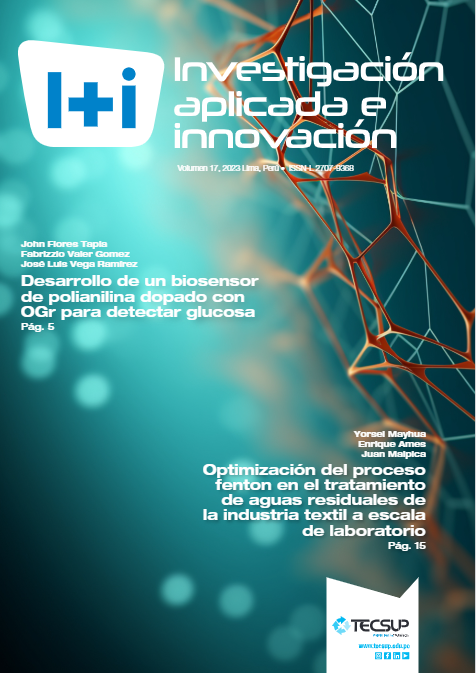Development of a rGO-doped polyaniline biosensor to detect glucose
DOI:
https://doi.org/10.71701/b741pz21Keywords:
Enzymatic biosensor, polyaniline PAni, reduced graphene oxide rGO, glucose oxidase, redox reaction, cyclic voltamperometryAbstract
In this work, electrochemical sensors were designed and manufactured using a Printed Circuit Board coated with copper foil as substrate. These sensors were developed using a matrix of the conductive polymer polyaniline and the nanostructured compound of reduced graphene oxide, and were applied two different drying methods: infrared light and spin coating. Then, the glucose oxidase enzyme of high specificity was immobilized with glutaraldehyde solution. The sensors were analyzed in the presence of a D-Glucose solution at a concentration of 16 mM. The electrochemical activity was measured using the cyclic voltamperometry technique. As for the results, those samples dried with infrared light displayed better performance at scan rates of 0.3 to 0.8 mV/s with a high charge transfer of 0.8 mV/s and reversibility. On the other hand, the electrodes dried with the spin coating method did not show reversibility. With this technique it is highly likely to develop biosensors to detect glucose in diabetic people in Peru.
Downloads
References
Bilgi, M., Sahin, E. M., y Ayranci, E. (2018). Sensor and biosensor application of a new redox mediator: Rosmarinic acid modified screen-printed carbon electrode for electrochemical determination of NADH and ethanol. Journal of Electroanalytical Chemistry, 813, 67-74.
Christwardana, M., y Kwon, Y. (2015). Effects of multiple polyaniline layers immobilized on carbon nanotube and glutaraldehyde on performance and stability of biofuel cell. Journal of Power Sources, 299, 604-610.
Hu, F., Li, W., Zhang, J., & Meng, W. (2014). Effect of graphene oxide as a dopant on the electrochemical performance of graphene oxide/polyaniline composite. Journal of Materials Science & Technology, 30(4), 321-327.
Luong, A. D., Roy, I., Malhotra, B. D., & Luong, J. H. (2021). Analytical and biosensing platforms for insulin: a review. Sensors and Actuators Reports, 3, 100028. doi: 10.1016/J.SNR.2021.100028.
Maity, D., Minitha, C., y Rajendra, K. (2019). Glucose oxidase immobilized amine terminated multiwall carbon nanotubes/reduced graphene oxide/polyaniline/gold nanoparticles modified screen-printed carbon electrode for highly sensitive amperometric glucose detection. Materials Science and Engineering, 105:110075. doi: 10.1016/j. msec.2019.110075.
Nuñez-Chavez, O., Mayorga, Untiveros-Mayorga, C., Tapia-Zegarra, L. (2004). Diabetes mellitus tipo 2 en el Hospital II Essalud-Cañete: Aspectos demográficos y clínicos. Revista Médica Herediana, 15(1), 19-23.
Pletcher, D., Greff, R., Peat, R., Peter, L., y Robinson, J. (2001). Instrumental Methods in Electrochemistry. Elsevier.
Serafín González-Carrato, V. (2015). Biosensores electroquímicos basados en nanomateriales y en materiales magnéticos para la determinación de analitos de interés bioquímico.
Suzuki, N., Lee, J., Loew, N., Takahashi-Inose, Y., Okuda-Shimazaki, J., Kojima, K., ... & Sode, K. (2020). Engineered glucose oxidase capable of quasi-direct electron transfer after a quick-and-easy modification with a mediator. International Journal of Molecular Sciences, 21(3), 1137. doi: 10.3390/ijms21031137.
Downloads
Published
Issue
Section
License

This work is licensed under a Creative Commons Attribution-NonCommercial 4.0 International License.


